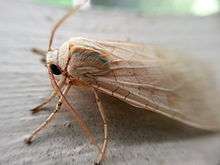Halysidota tessellaris
| Halysidota tessellaris | |
|---|---|
 | |
| Scientific classification | |
| Kingdom: | Animalia |
| Phylum: | Arthropoda |
| Class: | Insecta |
| Order: | Lepidoptera |
| Superfamily: | Noctuoidea |
| Family: | Erebidae |
| Genus: | Halysidota |
| Species: | H. tessellaris |
| Binomial name | |
| Halysidota tessellaris (J.E. Smith, 1797) | |
| Synonyms | |
| |
Halysidota tessellaris, also called the banded tussock moth, tessellated halisidota, and pale tiger moth, is in Erebidae. Like many related species, it has chemical defenses it acquires from its host plants, in this case, alkaloids (Weller et al., 1999, Hristov and Conner 2005), at least in adults. Larval brazen behaviours suggest that they are chemically protected; they have not been analyzed for alkaloid content.
Range
This moth is found from southern Canada south through Texas and central Florida in North America (Wagner 2005).
Life cycle
One generation per year occurs in the north, and two or more occur in the south (Wagner 2005).
Egg
Eggs are laid in masses on the undersides of leaves (Rose and Lindquist, 1982).
Larva
Caterpillars are covered with long setae, in tufts. They vary from yellowish and orange through dark gray. Extra long 'hair pencils' of white, black, and/or orange occur at both the front and rear of a caterpillar. Larval head capsules are bright orange. In the north, mature caterpillars are found from July to frost (Wagner 2005). Caterpillars frequently rest on the upper surface of leaves, and though not gregarious, they are very conspicuous (Wagner 2005). They grow to a length of 35 mm.
Pupa
Pupae overwinter in gray cocoons laced with larval hairs (Wagner, 2005).
Adults
Wings are light brown. Forewings have bands of beige edged in black. The body is 'hairy' and yellow. The thorax has blue-green lines on its upper sides. Adults are attracted to decaying plants with pyrrolizidine alkaloids (Krasnof and Dussourd, 1989). They regurgitate on them, then drink the fluids, and acquire defensive chemicals.

Food plants
Larvae are known to feed on some species of alder, ash, birch, blueberry, chestnut, elm, grape, hackberry, hazel, oak, walnut, willow, and many others (Wagner, 2005). No serious injury to trees has been reported for this late-season feeder (Rose and Lindquist, 1982).
References
- ↑ Hodges, R.W (1983). "Halysidota tessellaris". NatureServe. Retrieved 18 July 2013.
- Krasnoff SB, and DE Dussourd, (1989) Dihydropyrrolizine attractants for arctiid moths that visit plants containing pyrrolizidine alkaloids. Journal of Chemical Ecology 15: 47-60.
- Hristov, NL, and WE Conner, 2005. Effectiveness of tiger moth (Lepidoptera, Arctiidae) chemical defenses against an insectivorous bat (Eptesicus fuscus). Chemoecology 15(2):105-113.
- Rose, AH and OH Lindquist (1982). Insects of eastern hardwood trees. Canadian Forestry service, Forestry Tech Rep 29. Government of Canada, Ottawa. ISBN 0-660-11205-1.
- Wagner, DL, (2005) Caterpillars of Eastern North America. Princeton University Press.
- Weller SJ, Jacobsen NL, Conner WE (1999) The evolution of chemical defenses and mating systems in tiger moths (Lepidoptera: Arctiidae). Biol J Linn Soc 68:557–578
External links
| Wikimedia Commons has media related to Halysidota tessellaris. |
